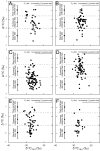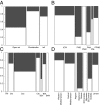Regional asynchronicity in dairy production and processing in early farming communities of the northern Mediterranean
- PMID: 27849595
- PMCID: PMC5137723
- DOI: 10.1073/pnas.1607810113
Regional asynchronicity in dairy production and processing in early farming communities of the northern Mediterranean
Erratum in
-
Correction for Debono Spiteri et al., Regional asynchronicity in dairy production and processing in early farming communities of the northern Mediterranean.Proc Natl Acad Sci U S A. 2017 Jan 3;114(1):E105-E106. doi: 10.1073/pnas.1619646114. Epub 2016 Dec 27. Proc Natl Acad Sci U S A. 2017. PMID: 28028210 Free PMC article. No abstract available.
Abstract
In the absence of any direct evidence, the relative importance of meat and dairy productions to Neolithic prehistoric Mediterranean communities has been extensively debated. Here, we combine lipid residue analysis of ceramic vessels with osteo-archaeological age-at-death analysis from 82 northern Mediterranean and Near Eastern sites dating from the seventh to fifth millennia BC to address this question. The findings show variable intensities in dairy and nondairy activities in the Mediterranean region with the slaughter profiles of domesticated ruminants mirroring the results of the organic residue analyses. The finding of milk residues in very early Neolithic pottery (seventh millennium BC) from both the east and west of the region contrasts with much lower intensities in sites of northern Greece, where pig bones are present in higher frequencies compared with other locations. In this region, the slaughter profiles of all domesticated ruminants suggest meat production predominated. Overall, it appears that milk or the by-products of milk was an important foodstuff, which may have contributed significantly to the spread of these cultural groups by providing a nourishing and sustainable product for early farming communities.
Keywords: Neolithic; archaeology; archaeozoology; lipid residue analyses; milk.
Conflict of interest statement
The authors declare no conflict of interest.
Figures




References
-
- Peters J, von den Driesch A, Helmer D. The upper Euphrates-Tigris basin: Cradle of agro-pastoralism? In: Vigne JD, Peters J, Helmer D, editors. Proceedings of the 9th Conference of the International Council of Archaeozoology 2002, Durham, First Steps of Animal Domestication, New Archaeozoological Approaches. Oxbow Books; Oxford: 2005. pp. 96–124.
-
- Vigne J-D. The origins of animal domestication and husbandry: A major change in the history of humanity and the biosphere. C R Biol. 2011;334(3):171–181. - PubMed
-
- Helmer D, Gourichon L, Vila E. The development of the exploitation of products from Capra and Ovis (meat, milk and fleece) from the PPNB to the Early Bronze in the northern Near East (8700 to 2000 BC cal.) Anthropozoologica. 2007;42(2):41–69.
-
- Vigne J-D, Helmer D. Was milk a “secondary product” in the Old World Neolithisation process? Its role in the domestication of cattle, sheep and goats. Anthropozoologica. 2007;42(2):9–40.
-
- Payne S. Kill-off patterns in sheep and goats: The mandibles from Aşvan Kale. Anatolian Studies. 1973;23:281–303.
Publication types
MeSH terms
Substances
LinkOut - more resources
Full Text Sources
Other Literature Sources

